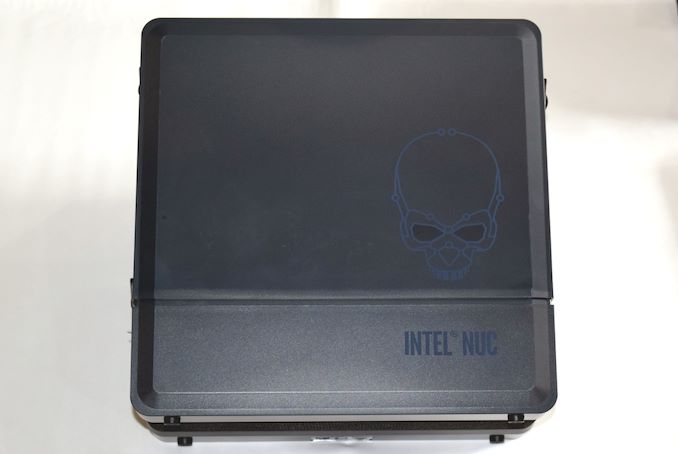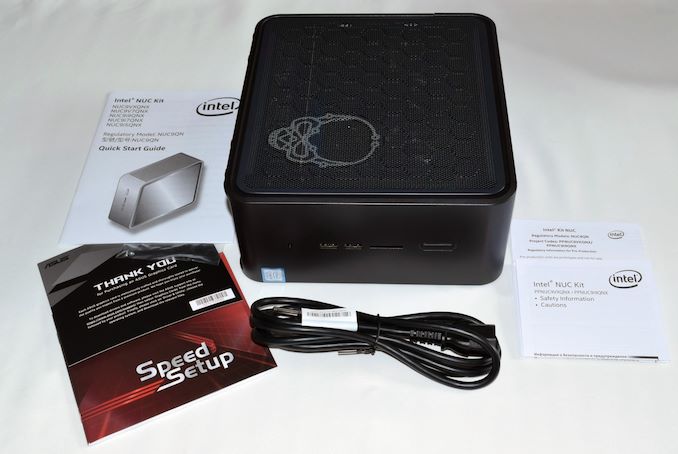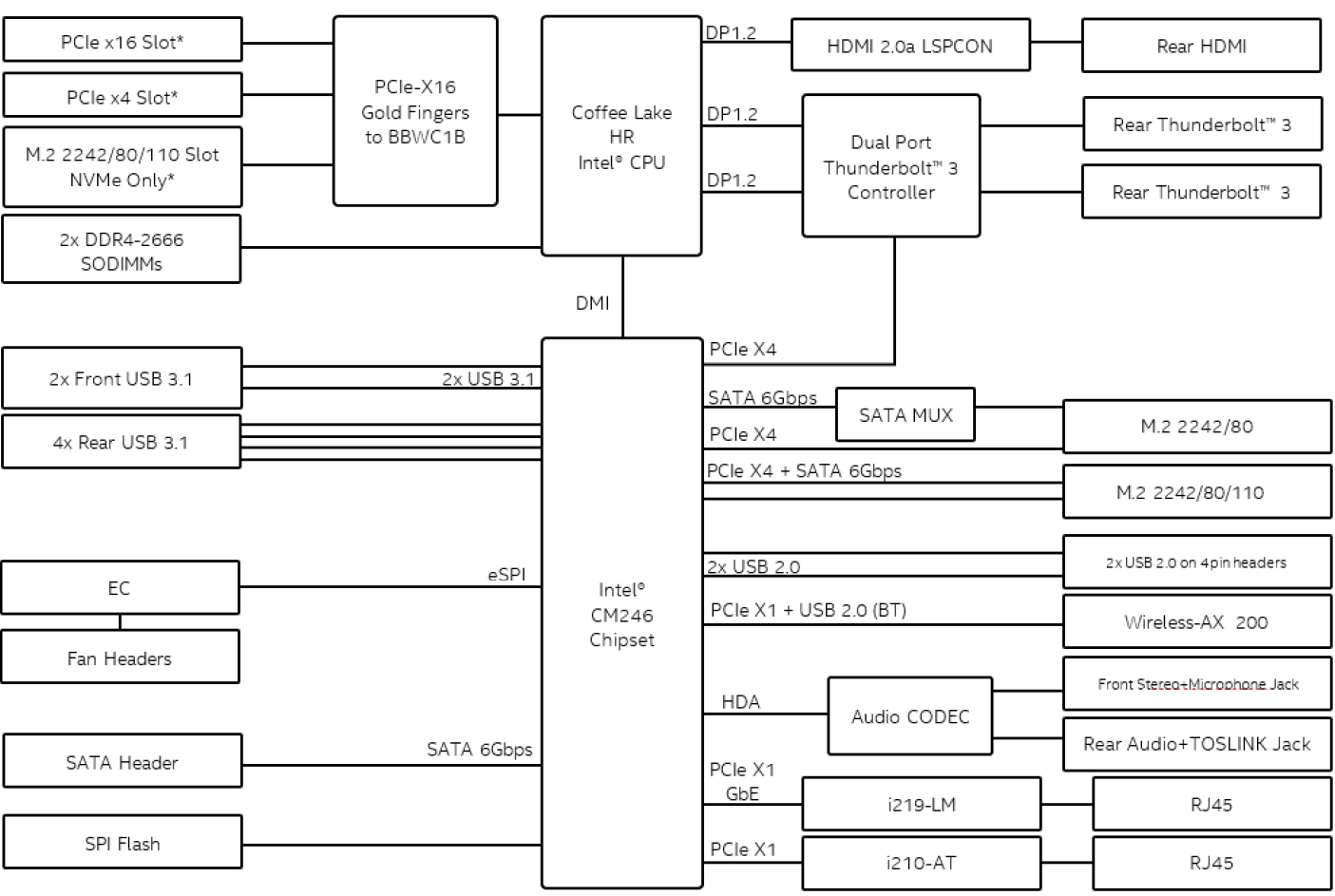Intel Ghost Canyon NUC9i9QNX Review: NUC 9 Extreme Realizes the SFF Dream
by Ganesh T S on April 16, 2020 8:05 AM ESTSetup Notes and Platform Analysis
The NUC 9 Extreme Kit is packaged in a fancy hard casing, signifying its premium nature. Since we had a system configuration essentially ready to benchmark, the package contents only included a few manuals and regulatory information notes along with a US power cord.
We noted the re-design of the Visual BIOS in our Frost Canyon NUC review. The NUC9i9QNX also uses the same re-designed interface. Unlike the mainstream NUC10i7FNH, the NUC9i9QNX has a few enthusiast options including the ability to fine-tune the DRAM timing parameters from a performance perspective. The entire gamut of options available in the latest BIOS (v0034) of the NUC9i9QNX is brought out in the gallery below.
The specifications of our Intel NUC9i9QNX review configuration are summarized in the table below.
| Intel NUC9i9QNX (Ghost Canyon) Specifications | |
| Processor | Intel Core i9-9980HK Coffee Lake-H, 8C/16T, 2.4 (5.0) GHz 16MB L2+L3, 14nm (optimized), 45W TDP |
| Memory | Kingston HyperX KHX3200C20S4/8G DDR4 SODIMM 17-19-19-35 @ 2666 MHz 2x8 GB |
| Graphics | ASUS Dual GeForce RTX 2070 MINI 8GB GDDR6 Intel UHD Graphics 630 |
| Disk Drive(s) | Intel SSD 905p Optane SSDPEL1D380GA (380 GB; M.2 Type 22110 PCIe 3.0 x4 NVMe; Optane / 3D XPoint) Kingston KC2000 SKC2000M81000G (1TB; M.2 Type 2280 PCIe 3.0 x4 NVMe; Toshiba 96L 3D TLC; Silicon Motion SM2262EN Controller) |
| Networking | Intel Wi-Fi 6 AX200 (2x2 802.11ax - 2400 Mbps) 1x Intel I219-LM Gigabit Ethernet Adapter 1x Intel I210 Gigabit Ethernet Adapter |
| Audio | 3.5mm Audio Jack (Front) Optical TOSLINK output (Rear) Capable of 5.1/7.1 digital output with HD audio bitstreaming (HDMI) |
| Miscellaneous I/O Ports | 1x UHS-II SDXC Slot (Front) 2x USB 3.2 Gen 2 (10 Gbps) Type-A (Front) 4x USB 3.2 Gen 2 (10 Gbps) Type-A (Rear) 2x Thunderbolt 3 (40 Gbps) Type-C (Rear) |
| Operating System | Retail unit is barebones, but we installed Windows 10 Enterprise x64 |
| Pricing (As configured) | $2810 |
| Full Specifications | Intel NUC9i9QNX Specifications |
The block diagram of the components of the NUC9i9QNX are presented in the diagram below.
One of the aspects that needs to be pointed out here is that the 2x Front USB 3.1 ports specified in the diagram above are physically the ones on the Compute Element, and not on the front panel of the chassis. The diagram does bring out the PCIe lanes bifurcation in the baseboard, though.
Our review sample came with Windows 10 Home x64 pre-installed, but, we wiped the drive and installed Windows 10 Enterprise x64 1909 along with the March 2020 cumulative updates prior to benchmarking. Our initial benchmarking and reports collection was done without opening up the system. The AIDA64 system report for the hardware configuration supplied by Intel provided the following information:
- [ North Bridge: Intel Comet Lake-H IMC ]:
- PCIe 3.0 x8 port #2 In Use @ x8 (nVIDIA GeForce RTX 2070 Video Adapter, nVIDIA TU106 - High Definition Audio Controller)
- PCIe 3.0 x4 port #4 In Use @ x4 (Intel Optane SSD 900p NVMe Controller)
- [ South Bridge: Intel Cannon Point CM246 ]:
- PCIe 3.0 x1 port #1 In Use @ x1 (Intel Wi-Fi 6 AX200 160MHz Wireless Network Adapter)
- PCIe 3.0 x4 port #5 In Use @ x4 (Intel Titan Ridge Thunderbolt 3 Controller)
- PCIe 3.0 x4 port #9 In Use @ x4 (Silicon Motion SM2262 PCIe 3.0 x4 NVMe 1.3 SSD Controller - Kingston KC2000)
- PCIe 3.0 x1 port #14 In Use @ x1 (Intel I210 Gigabit Network Connection)
We were puzzled by the discrete GPU operating in x8 mode instead of x16 (as it could affect gaming performance). After reaching out to Intel, we got additional context for the review configuration. As noted briefly a bit earlier, the M.2 slot on the baseboard is directly attached to the CPU, using PCIe lanes from it rather than off of the chipset. So the power-hungry, but high-performance 905p Optane drive in the baseboard slot makes sense in that context, as Intel is giving it the best possible (and least contested) connection to the CPU in order to highlight the capabilities of CPU-attached storage.
As evident from the block diagram, the Thunderbolt ports, USB ports, and the M.2 slots on the Compute Element are attached to the chipset, which means sharing the DMI link and its maximum bandwidth of PCIe 3.0 x4 (4GB/s). Which compared to typical systems, is actually a lighter load than usual; by hanging the Optane drive off of the CPU, there's less contention for the rest of the DMI link's resources, enabling additional testing areas such as elimination of noise from Thunderbolt 3 testing and allowing for RAID-0/1 on the Compute Element. Overall this opens up a few different configuration options, so in order to highlight the pros and cons of splitting the x16 slot with a SSD, we also tested the NUC with the Optane drive hanging off of the PCH, giving the video card a full x16 slot's worth of bandwidth. This is noted as x16 in the rest of the review to signify the operation of the RTX 2070 in x16 mode.
The AIDA64 system report for the x16 configuration has a slightly tweaked version of the PCIe lane usage specified earlier:
- [ North Bridge: Intel Comet Lake-H IMC ]:
- PCIe 3.0 x16 port #2 In Use @ x8 (nVIDIA GeForce RTX 2070 Video Adapter, nVIDIA TU106 - High Definition Audio Controller)
- [ South Bridge: Intel Cannon Point CM246 ]:
- PCIe 3.0 x1 port #1 In Use @ x1 (Intel Wi-Fi 6 AX200 160MHz Wireless Network Adapter)
- PCIe 3.0 x4 port #5 In Use @ x4 (Intel Titan Ridge Thunderbolt 3 Controller)
- PCIe 3.0 x4 port #9 In Use @ x4 (Intel Optane SSD 900p NVMe Controller)
- PCIe 3.0 x1 port #14 In Use @ x1 (Intel I210 Gigabit Network Connection)
- PCIe 3.0 x4 port #21 In Use @ x4 (Silicon Motion SM2262 PCIe 3.0 x4 NVMe 1.3 SSD Controller - Kingston KC2000)
The NUC9i9QNX is a relatively unique system. We have evaluated SFF systems with discrete GPUs in the last few years. Systems such as the Hades Canyon NUC came with a co-packaged discrete GPU leaving no scope for the end-user to upgrade the graphics performance without buying an entirely new computer. We've also had systems with a real discrete GPU such as the ASRock DeskMini Z370 GTX1060 and the Zotac ZBOX MAGNUS EN1080K. Theoretically, users could upgrade the installed MXM card to get better graphics performance, but practically speaking, MXM card upgrades are incredibly rare and almost never officially supported by system manufacturers.
This leaves us with one true precursor to the Ghost Canyon NUC - the Zotac ZBOX MAGNUS EK71080. This 5.7L compact gaming powerhouse internally sports a single-fan version of the Zotac GTX 1080 Mini complete with the external PCIe power connector, and nothing preventing the end-user from replacing it with a similar-sized GPU. Obviously, Zotac would not officially support this, but it only serves to show that accommodation of user-replaceable discrete GPUs in compact SFF systems has been possible before. The Compute Element initiative from Intel has been accompanied by the creation of an ecosystem where add-in card vendors now have an incentive to create discrete GPU cards within the 202mm x 131mm form-factor. Along with chassis designs like the one in the NUC9i9QNX, this has now enabled sub-5L systems capable of sporting powerful user-replaceable discrete GPUs.
In the table below, we have an overview of the various systems that we are comparing the Intel NUC9i9QNX against. Note that they may not belong to the same market segment. The relevant configuration details of the machines are provided so that readers have an understanding of why some benchmark numbers are skewed for or against the Intel NUC9i9QNX when we come to those sections.
| Comparative PC Configurations | ||
| Aspect | Intel NUC9i9QNX (Ghost Canyon) | |
| CPU | Intel Core i9-9980HK | Intel Core i9-9980HK |
| GPU | ASUS Dual GeForce RTX 2070 MINI 8GB GDDR6 Intel UHD Graphics 630 |
ASUS Dual GeForce RTX 2070 MINI 8GB GDDR6 Intel UHD Graphics 630 |
| RAM | Kingston HyperX KHX3200C20S4/8G DDR4 SODIMM 17-19-19-35 @ 2666 MHz 2x8 GB |
Kingston HyperX KHX3200C20S4/8G DDR4 SODIMM 17-19-19-35 @ 2666 MHz 2x8 GB |
| Storage | Intel SSD 905p Optane SSDPEL1D380GA (380 GB; M.2 Type 22110 PCIe 3.0 x4 NVMe; Optane / 3D XPoint) Kingston KC2000 SKC2000M81000G (1TB; M.2 Type 2280 PCIe 3.0 x4 NVMe; Toshiba 96L 3D TLC; Silicon Motion SM2262EN Controller) |
Intel SSD 905p Optane SSDPEL1D380GA (380 GB; M.2 Type 22110 PCIe 3.0 x4 NVMe; Optane / 3D XPoint) Kingston KC2000 SKC2000M81000G (1TB; M.2 Type 2280 PCIe 3.0 x4 NVMe; Toshiba 96L 3D TLC; Silicon Motion SM2262EN Controller) |
| Wi-Fi | Intel Wi-Fi 6 AX200 (2x2 802.11ax - 2400 Mbps) |
Intel Wi-Fi 6 AX200 (2x2 802.11ax - 2400 Mbps) |
| Price (in USD, when built) | $1553 (barebones) $2810 (as configured) |
$1553 (barebones) $2810 (as configured) |



















109 Comments
View All Comments
buckiller - Thursday, April 16, 2020 - link
Power pig. Hades Canyon was great, but this is hot trash, relative to expectations set by last-gen and perf/power capabilities that are possible today.> The Ghost Canyon NUC9i9QNX is a SFF enthusiast's dream come true.
Ooph. Hardly.
Dolda2000 - Thursday, April 16, 2020 - link
I have to admit that I still don't really see the point of this system. It seems that its main gimmick is the fact that what is essentially the motherboard plugs into a PCIe riser card. That's fine and useful and all, but PCIe riser boards and cables are nothing new, and I don't really see what this does that hasn't already been doable for quite some time. You can replace the compute element? Sure, but being able to replace motherboards is nothing new to most form factors. Please do enlighten me if I'm missing something.Dragonstongue - Thursday, April 16, 2020 - link
the series adds the ability for end-users to add a standard PCIe video card to the system system.to the system's system ... or just to the system..
as for folks complain about the price, CPU alone is ~580 USD .. RTX 2070 mini ~539
so there is over $1k right there
I personally wouldn't be buying NUC "overall" based on should be Ryzen A and B absolutely not given seems Intel is "up to their same old BS tricks" via "preventing" folks from offering AMD based options available...
Destoya - Thursday, April 16, 2020 - link
$580 CPU, you have to be kidding. Nobody, including OEMs, pays the tray MSRP intel has listed.If you want to look at it in terms of value, it has the same performance as a Ryzen 3600 ($175)...
Deicidium369 - Thursday, April 16, 2020 - link
First off, there are no OEMs, it is single source Intel. I love Intel NUCs - not sure what the use case for this model is.Namisecond - Friday, April 17, 2020 - link
I don't think Intel manufactures those CPU cards (soldered BGA CPUs). They're probably integrated by a 3rd party OEM like Foxxcon. It's one thing to have engineering samples, but for Intel to step into the motherboard manufacturing game requires a lot of capital resources...unless the NUC parts are actually going to be made at Intel's engineering labs...If it's a production run in the 10Ks...that just might be feasible.Deicidium369 - Friday, April 17, 2020 - link
And like I said there are no OEMs available for you to buy from - single source - Intel. I thought I saw something a few years ago about possibly PNY - I know they do the Nvidia branded graphics cards.BlazingDragon - Thursday, April 16, 2020 - link
The article is misleading... and very Intel biased, IMHO.The ~$1500 USD price is for the i9 barebones kit only... just compute element [w/CPU], daughter board and PSU - i.e. not including a GPU, DRAM memory or SSD - that's why it's so outlandish...
Good ITX m/board & Ryzen 3900x CPU, plus really nice case and PSU is << $900 USD.
Deicidium369 - Thursday, April 16, 2020 - link
So a review of a product from Intel is very Intel biased.... That has to be a huge conspira-plotBlazingDragon - Thursday, April 16, 2020 - link
A review of anything can be positive or negative on that thing... and is unbiased if it seems balanced and fair in that criticism [be it positive or negative].If said article seems to over exaggerate the positives, and/or misrepresent them, and miss out or under call some of the negatives, then yes, it's biased... and IMHO, that's exactly what this article does...